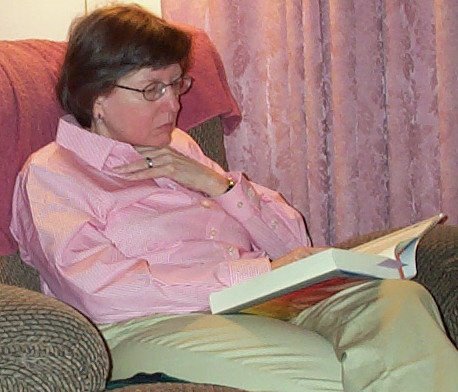Tea Is in Fashion
Nobody loves tea as I do. Not even Samuel Johnson, who purportedly drank 50 cups during an evening in the drawing room of his patroness, Mrs Thrale. But as the Snickers commercial points out, some things are satisfying only if you ingest them.
The NY Times today has a story about an outfit made by costume designer Brett Cooper. Mr Cooper’s reputation is based on the costumes he created for two drag queens and a transvestite in 1994’s “Priscilla Queen of the Dessert” and a dress made from American Express credit cards, which is something I should think would be more in Martha Stewart’s line. His fellow designer for “Priscilla” wore his Gold Card creation to the Academy Awards, where she won an Oscar for – you guessed it – costume design.
This time Mr Cooper’s fashion statement is made from tea bag envelopes and boxes. He couldn't use tea bags because, as he points out, no woman needs the padding, even if it’s oolong or Darjeeling. This little tea package number is intended to attract attention to an upcoming Celestial Seasonings promotion to raise money for WomenHeart: the National Coalition for Women with Heart Disease. Good for Celestial Seasonings. Heart disease is the leading cause of death for American women and most women don’t know that.
My friend Sarah visited the Celestial Seasonings factory a while back and brought me some Sleepytime Extra, which is what I drink when I wake in the night and can’t get back to sleep. Sarah knows I particularly like things that are labeled extra, or double, or fortified, or industrial strength. (I don’t do drugs and alcohol and we all have to get our kicks where we can.)
Apparently the highlight of the Celestial Seasonings tour is the mint room. Sarah reached for terms like brisk and bracing to describe the experience. Snappy, exhilarating, rousing, sharp, stimulating. (I think she meant painful.) Those adjectives are excellent descriptors of many teas. (Well, not painful, excepting maybe lapsang souchong, an ashtray flavored brew which appeals to those who prefer single-malt Scotch and cigars.) Also appropriate to describe tea are soothing, solacing, consoling, quenching, refreshing, warming, and restorative. There’s nothing like it. Coffee doesn’t even come close.
They’ve been telling us lately that tea is good for our hearts. (Also chocolate, but I’ll go into that at another time.) It’s also good for our minds and our spirits. It helps us to get to sleep or to stay awake. It’s cheering when we’re celebrating and assuageing when we’re sad. But I can’t say as it does much for our wardrobe.
Some books about tea from my library:
THE BOOK OF TEA (2000?) Preface by Anthony Burgess. This is an oversized “coffee" table book with lots of fine photos and illustrations, most of them in color.
THE WAY OF TEA, by Rand Castile (1971) Beautifully made, boxed, oversized.
HAVING TEA: Recipes and Table Settings (1986) by Tricia Foley.
TEATIME IN THE NORTHWEST (2001) by Sharon and Ken Foster-Lewis.
TIME FOR TEA: Travels through China and India in Search of Tea (1990) by Jason Goodwin. A history of the tea trade. A very fine book.
TEA TIME (1992) by M Dalton Smith. Miniature; it includes some recipes.
MURDER AT TEATIME (1991) by Stefanie Matteson. Third in the Charlotte Graham mystery series. It takes place in Maine.
A DECENT CUP OF TEA (1991) by Malachi McCormick. Tea and cake. An attractive small book with a decorative hand-made paper cover.
TEA LOVER’S TREASURY (1982) by James Norwood Pratt.
TEACRAFT: a Treasury of Romance, Rituals, and Recipes (1975) by Charles and Violet Schafer.
THE LONDON RITZ BOOK OF AFTERNOON TEA (1986) by Helen Simtson. Inlcudes recipes. When I had tea there a gentleman at the next table wore a dove grey morning coat and top hat and a monocle. It was Derby Day.
THE AFTERNOON TEA BOOK (1986) by Michael Smith. The proper term for a twee tea party is “afternoon tea,” not “high tea,” as one so often sees it miscalled. High tea is a working class meal; it’s supper. This incorrect usage annoys me almost as much as the use of “home” when one means “house.”
TEA WITH JANE AUSTEN (2004) by Kim Wilson. See my blog entry “Reading List Details," Tuesday, 17 January 2006.
JAPAN: The Art of the Tea Ceremony (1988) This is an informative little pamphlet I picked up at a National Gallery exhibit where I got to see an actual, if nomadic, Japanese tea house.
Then there are Laura Childs’ teashop mysteries. (I always find a way to talk about murder mysteries no matter the ostensible subject.) These are set in Charleston, South Carolina.
DEATH BY DARJEELING (2001)
GUNPOWDER GREEN (2002)
SHADES OF EARL GREY (2003)
ENGLISH BREAKFAST MURDER (2003)
JASMINE MOON MURDER (2004)
CHAMOMILE MOURNING (2005)
BLOOD ORANGE BREWING (April 2006)
Here are two books with tea in the title that I’ve borrowed from the library:
A CUP OF TEA (1997) by Amy Ephron. Fiction. In about 1913 or 14 a wealthy New York lady takes in a poor girl. Then her fiancé begins to find the girl a little too interesting. This isn’t quite literature, but it’s not a Harlequin Romance either.
MR PUTTER AND TABBY POUR THE TEA (1994) by Cynthia Rylant. The first in the Mr Putter and Tabby series of children’s books. I’m grateful to Phyllis for telling me about Mr Putter, his cat, and their friend Mrs Teaberry. I love ‘em.
And finally, for the latest medical thinking about women and heart disease:
TOTAL HEART HEALTH FOR WOMEN: A Life-Enriching Plan for Physical and Spiritual Well-Being (2006) by H Edwin Young, et al. (I haven't seen this book yet.)


0 Comments:
Post a Comment
Subscribe to Post Comments [Atom]
<< Home